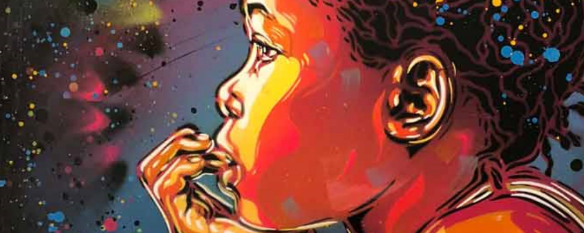Handling international shipping for your artwork involves several steps to ensure
that your package arrives safely and complies with all necessary regulations. Here’s
a detailed guide:
- Research International Shipping Regulations:
- Familiarise yourself with the import regulations of the destination country,
including restrictions on certain materials and items.
- Check for any specific documentation required for importing artwork.
2. Select a Reliable Shipping Carrier:
- Choose a carrier experienced in international shipping, such as DHL, FedEx,
UPS, or USPS.
- Consider factors such as delivery times, tracking capabilities, and insurance
options.
3. Properly Package Your Artwork:
- Use high-quality packaging materials to protect your artwork during transit.
- Wrap the artwork in protective materials such as glassine paper or bubble wrap.
- Use sturdy boxes and consider double-boxing for added protection.
- Include corner protectors to safeguard edges.
4. Prepare Documentation:
- Customs Declaration Form: Accurately complete the required customs
declaration forms, specifying the contents and value of the package.
- Commercial Invoice: Include a commercial invoice that details the
contents, value, and purpose of the shipment.
- Certificate of Authenticity: For valuable or original artwork, include a
certificate of authenticity if applicable.
- Import Licences: Check if the destination country requires any import
licences or special permits for artwork.
5. Calculate Shipping Costs and Duties:
- Use the carrier’s online shipping calculator to estimate shipping costs based on the
package’s dimensions, weight, and destination.
- Research and estimate potential customs duties and taxes that the recipient may need
to pay upon arrival.
6. Purchase Insurance:
- Insure your artwork for its full value to protect against loss or damage during transit.
- Check with the carrier for insurance options and coverage limits.
7. Label the Package Clearly
- Include the recipient’s full address, including country, postal code, and contact number.
- Attach all necessary shipping labels and customs documentation securely to the
package.
8. Select Tracking and Delivery Confirmation:
- Choose a shipping service that includes tracking and delivery confirmation to monitor
the shipment’s progress and ensure it reaches its destination.
9. Inform the Recipient:
- Provide the recipient with the tracking number and an estimated delivery date.
- Inform them about any potential customs duties or taxes they may need to pay upon
receipt.
10. Keep Records:
- Maintain copies of all shipping and customs documentation.
- Keep a record of the tracking number and any communication with the recipient and
carrier.
By following these steps, you can manage international shipping effectively, ensuring that
your artwork is delivered safely and in compliance with all relevant regulations.
When shipping your artwork, you have the flexibility to choose a courier company that best meets your needs for safe and reliable delivery. While Art.Africa recommends considering reputable options like DHL, FedEx, UPS, TNT, and Aramex for their global reach and reliability, using these specific companies is not mandatory.
However, if you opt for a courier service not listed above, please ensure they provide item tracking to ensure the secure transit and delivery of your artwork. This tracking capability is a requirement to ensure that shipments are traceable and accountable throughout the shipping process.
Setting up shipping for your artwork involves several steps to ensure it arrives
safely and efficiently at its destination. Here’s a comprehensive guide:
- Choose Shipping Carriers:
-Research and select reliable shipping carriers (e.g., FedEx, UPS, DHL,
USPS).
– Compare rates, delivery times, and services offered by each carrier.
- Packaging Materials:
– Obtain high-quality packaging materials, including sturdy boxes, bubble
wrap, packing peanuts, corner protectors, and tape.- Consider using custom or reinforced boxes for larger or fragile pieces.
- Packaging Your Artwork:
– Protect the artwork with a layer of glassine paper or acid-free tissue paper.
– Wrap the artwork in bubble wrap for cushioning.
– Use corner protectors to safeguard edges and corners.
– Place the wrapped artwork in a sturdy box with sufficient padding to prevent
movement during transit.
– Double-boxing (placing the box inside a larger box with additional padding) can
provide extra protection for fragile items.
- Shipping Labels and Documentation:
– Print and attach the shipping label securely to the package.
– Include a return address and contact information.
We accept a variety of payment methods for your convenience. The following list
refers:
- Debit & Credit Cards (Visa, Mastercard)
- PayPal
- Apple Pay
- Google Pay
It’s important to note that Art.Africa does not store any customer payment
information, ensuring your transactions remain secure and private.
Art.Africa prioritises secure transactions by leveraging trusted payment gateways
that adhere to the industry-standard PCI DSS (Payment Card Industry Data
Security Standard). This rigorous standard ensures the protection of sensitive
customer data like credit card information. To further safeguard your information,
Art.Africa itself does not process or store any payment details. All transactions are
securely handled on the side of our PCI-compliant payment processors. This
approach minimises the risk of data breaches and ensures the highest level of
security for your financial information.
Yes, you can offer discounts or promotions on Art.Africa! Sellers have the ability to
customise the negotiability of their artworks by setting a percentage in their
account settings. This percentage overrides the global percentage set by the admin,
which is currently 10%. It’s important to note that this customization applies
specifically to the “Make an Offer” feature.
The taxation of your artwork sales depends on your location and the buyer’s. Tax
obligations vary significantly by country and typically include VAT, GST, or other
applicable taxes. It’s essential to comply with local tax laws and regulations relevant
to your specific situation.
Payments are processed three weeks after the delivery of your artwork, or by the end of the month following delivery, whichever comes later. Payments will be made via bank transfer to your designated bank account.
For example, if your artwork is delivered on March 15th, you can expect to receive payment by April 5th (21 days after delivery) or by April 30th (end of the following month), depending on which date is later.
To ensure smooth receipt of payments, please keep your bank account information up-to-date.
Additionally, please note that we have a minimum payment threshold of £100. Payments will only be issued when your accumulated earnings meet or exceed this threshold. Earnings below this amount will be carried forward to the next payment cycle until the minimum threshold is reached.
To set the price of your artwork, consider the following guidelines:
- Research the market and understand what similar artworks are selling for in
your genre, medium, and size range.
- Calculate costs and factor in materials, time, and overhead expenses.
- Ensure your prices are competitive with other artists in your market.
Be open to negotiation and willing to adjust prices based on feedback and
sales data.
Remember, pricing your artwork is a balance between valuing your creative effort
and being realistic about what buyers are willing to pay.
Protecting your artwork from unauthorised use on Art.Africa is important. Here are
some steps you can take:
- Add a visible watermark to your images before uploading them. This can
deter unauthorised use.
- Embed your contact and copyright information into the metadata of your images before uploading them.
- Clearly display a copyright notice on your profile and artwork pages. This
informs viewers that your work is legally protected.
- Regularly search for your artwork online to ensure it isn’t being used without
permission. Tools like Google Reverse Image Search can help with this.
- If you find your artwork being used without authorization on Art.Africa or
other platforms, report it immediately to the site’s support team for
takedown.






